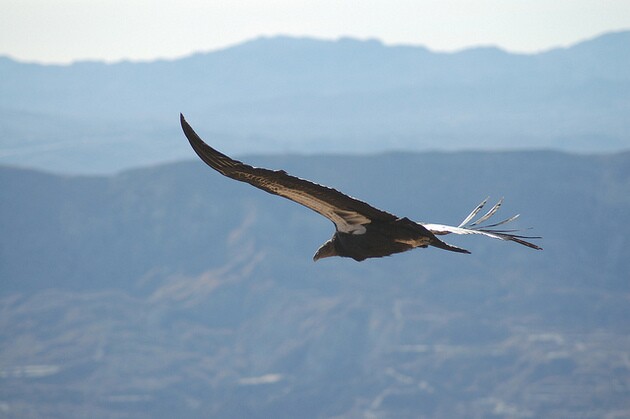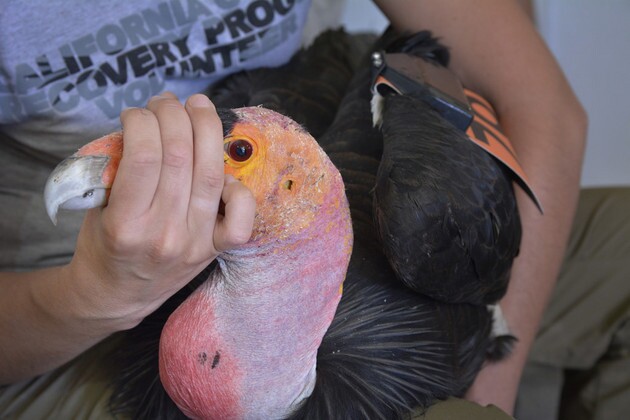The Deceptive Recovery of the California Condor

Thirty years ago, we almost lost the California condor. Its population had fallen to 21 in 1982. In a move that split the conservation community, leading to harsh invective, decades-long grudges, and at least one fistfight, all the free-flying condors were trapped and taken to the Los Angeles and San Diego Zoos for captive breeding.
By 1987, for the first time in tens of thousands of years, no condors patrolled the Southern California skies. Some thought that spelled the effective extinction of the species. Conservationist David Brower warned that captive-reared condors would be nothing but "flying pigs."
The first zoo-bred offspring were released into the wild in 1992. Today, according to the US Fish and Wildlife Service, the agency at the nexus of the Condor Recovery Program, there are 230 California condors in the wild: 128 in California, 73 in northern Arizona and southern Utah, 29 in Baja California. But this more than ten-fold increase in wild condors since 1982 isn't all good news.
Another 193 condors are in captivity, not just in Los Angeles and San Diego but in Santa Barbara, Portland, Mexico City, and the Peregrine Fund's breeding facility in Idaho. Last year 24 nests produced seven wild-fledged chicks; 21 captive-reared chicks were set free. "They're expanding, reoccupying their former range," says Eric Davis, who coordinates the program from the FWS regional office in Sacramento. Condors have shown up in Sequoia National Park in the southern Sierra Nevada, where they haven't nested since 1950.
This video, provided by the U.S. Fish and Wildlife Service's Condor Recovery Program, does a good job of explaining the successes in the program.
But adults are dying in the wild, from wildfires, collisions with power lines, predation by mountain lions. There's a strong scientific consensus that lead poisoning from ammunition in animal carcasses is the number-one killer. The deaths continue despite limits on lead ammunition in California and outreach efforts elsewhere. Those who have done the math, like environmental toxicologist Myra Finkelstein at UC Santa Cruz, speak of a "deceptive recovery," contending the wild condor population can't become self-sustaining until the lead problem is addressed. Meanwhile, with a substantial proportion of the population trapped and treated for lead toxicity every year, the California condor remains a species in intensive care.
Condor 101: Gymnogyps californianus is an enormous vulture, related to the ubiquitous turkey vulture and more distantly to the Old World vultures, hawks, and eagles. With nine-foot wingspans, condors are masters of the air, riding the winds effortlessly for hundreds of miles at a stretch. Like their smaller kin, they feed on carrion left by predators including human hunters. They locate food by sight. They form long-term pair bonds, producing one egg per nesting attempt and, with luck, a chick every year and a half. Condors are long-lived (a male called Topa Topa has been in captivity for 47 years), curious, and sociable, and those who've worked with them speak highly of their intelligence.
During the Pleistocene, condors ranged as far as Florida and New York. But their core habitat has probably always been western. In Southern California, an Ice Age bestiary --mammoths, ground sloths, wild horses -- provided an ample buffet shared with other scavenger birds like the larger, long-extinct teratorns. Scientists who've analyzed carbon and nitrogen isotopes in condor bones from the La Brea tar pits and elsewhere have found chemical signs that the birds also fed on beached whales and other marine mammals.

When the megafauna died out some 10,000 years ago, pickings became slim. The immense cattle herds on the 19th-century California ranchos provided short-term bounty. Now, apart from the Big Sur birds that have access to marine mammals, most free-flying condors depend on either dead calves left at provisioning stations or the remains of deer and wild pigs discarded or not retrieved by hunters. The apex predators that brought down the mammoths and sloths -- sabertooth cats and American lions, dire wolves and short-faced bears -- are gone. We're the apex predators now: for the condors, a mixed blessing.
And only seven chicks from 24 nests? Some eggs fail to hatch, some chicks die before they fledge. Some chicks die of microtrash ingestion. For reasons that remain unclear - maybe mistaking the stuff for bone fragments, a source of supplemental calcium -- condor parents bring bottle caps, glass fragments, and other debris to their nests; chicks swallow it but can't digest it. A study headed by Bruce Rideout of the San Diego Zoo blamed trash ingestion for at least eight of 16 nestling deaths in the wild through 2009. The problem is worst in Southern California. Attempts to alleviate it have included physically removing trash from active nests, and providing bone chips.
A more insidious threat has surfaced among the Big Sur condors: their eggs have thinner shells than those of captives or wild condors prior to the 1960s. DDE, a breakdown product of the pesticide DDT, was associated with eggshell-thinning in brown pelicans, bald eagles, and other large birds then, and is implicated in the Big Sur problem. Joe Burnett of the Ventana Wildlife Society and his co-authors in a 2013 article suggest that the condors are acquiring DDE from the sea lions and other marine mammals they scavenge.
The ultimate source may be the DDT dumped in the ocean off Los Angeles by the Montrose Chemical Corporation through 1971, still propagating through marine food webs. Finkelstein says she and her colleagues were unable to definitely link DDE in marine mammal carcasses on the central coast to Montrose: "There's no chemical fingerprint." Burnett is unconvinced. "The amount of DDT they pumped into the Southern Bight is globally unprecedented and pales in comparison to local residual sources from agricultural runoff," he says. "Just those sheer numbers implicate Montrose as the primary source of DDT contamination in California sea lions. I'm not sure a fingerprint is necessary." Burnett's follow-up research on the problem will be published early this year.

As wind power installations proliferate, fatal collisions with the turbines seem inevitable. "There's not going to be a perfect place where there are condors and no wind," says Davis. "There's no way to get the risk to zero."
FWS has been working with wind power companies; some have been receptive to siting recommendations. At the Alta East project in the Tehachapi Mountains, observers scan for condors and track signals from radio transmitters, and are authorized to shut the turbines down if one of the birds gets too close.
At least seven condors appear to have died in wildfires, an increasing concern as climate change reshapes regional fire regimes. Real estate development continues to eat into the birds' foraging habitat.
While these are evolving threats, lead ammunition is a clear and present danger. In Rideout's analysis, lead toxicosis killed 35 of the 85 adult and juvenile condors that died from 1992 through 2009. Some had fragments of lead shot in their guts. Although lead paint was implicated in one, the distinctive isotopic signature of lead bullets was common. Ten of 40 mortalities in 2013 were lead-related, with three others unresolved. For 2014, the most recent year for which FWS data is available, there were two confirmed lead deaths, 15 toxicology reports pending. The toll would have been higher if ailing condors -- 32 in 2011, 26 in 2012 -- had not been taken into captivity for chelation therapy. Lead exposure may also have sublethal effects that interfere with reproduction.

Blood lead levels in condors show seasonal patterns that differ among regions. Peaks in fall correlate with deer season. Other trends are harder to account for. "A lot of use is not necessarily deer hunting," says Finkelstein. Feral pig hunting happens year-round and is growing in popularity. Varmint shooting, depredation kills of coyotes, dispatching sick or injured livestock, and poaching also probably contribute but are impossible to quantify.
Despite two California laws restricting lead ammunition (one to be completely phased in this year) exposure rates in the state's condors have not dropped. Ironically, according to a study headed by Terra Kelly at UC Davis, the birds least dependent on human provisioning -- those, in short, that behave most like wild condors -- have the highest exposure. In a 2012 article, Finkelstein and colleagues looked at the demographics and made a grim projection: "Without continued management to prevent lead-related deaths, the wild condor population is predicted to again face the substantial threat of extinction in the coming decades."
Continued management, of course, has a price tag. A blue-ribbon panel convened by the American Ornithologists' Union reported in 2010 that over $5 million was being spent annually on the recovery program -- captive breeding, emergency medical treatment, monitoring, outreach. Much of the funding came from private partners like the zoos, the Ventana Wildlife Society, and the Peregrine Fund; federal sources accounted for less than a million. How sustainable will this be?
From the outset, the condor recovery effort has been an exercise in adaptive management. Aversion training for captive-bred condors has reduced powerline collisions, and PG&E undergrounded one of its lines at Big Sur.

Then there was the issue of condors behaving badly. Some released juveniles fraternized with hikers and hang gliders. One lurked around the hot tubs at Esalen, no doubt stunting some seekers' spiritual growth. An adolescent gang invaded a home near Mount Pinos, dismantled a satellite dish, and ripped up a mattress. In Arizona, a young condor dropped in on a campsite, found a loaded pistol in a backpack, and walked around holding it by the trigger.
Such episodes led to new rearing practices to minimize interactions with human handlers, and to the release of a few wild-caught birds to act as role models. These days, there's much less inappropriate behavior.
Davis is optimistic -- probably a bona fide occupational qualification -- about lead: "We've already removed it from gasoline, paint, toys, waterfowl ammunition. When I look out 25 years, I think the lead problem will be largely solved." He sees removing the condor from the endangered list altogether as a realistic goal. That will require not only continued funding, but the political will to deal with lead ammunition -- not just in California, but in Arizona, Utah, and Baja California, which have no restrictive regulations, and in Oregon, across the border from a potential release site on Yurok tribal lands in northwestern California.
Is the goal worth it? "That's a societal question," Davis responds. "What's the value of nature? Of science? The image of wild condors continuing to fly is inspirational to the entire country."




